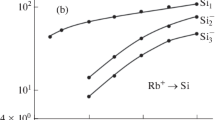Abstract
The formation process of M +2 molecular ions sputtered from elementary target materials is investigated. In a previous article it was shown that these molecules can be used to quantitate major elements [1]. The quantitation method was based on the assumption that the M +2 molecular ions are formed by the atomic combination of independently sputtered M and M + particles above the surface. In this paper this assumption will be investigated using a Monte Carlo model to simulate the formation mechanism. The model is used to calculate the velocity distribution of the M +2 dimers sputtered from three different elementary target materials (Fe, Ge, and Ni). The results are compared with experimental data. Good agreement exists between theory and experiment that supports the Monte Carlo model and hence also the assumed formation mechanism.
Similar content being viewed by others
References
Vlekken, J.; Wu, T. D.; D’Olieslaeger, M.; Knuyt, G.; Vandervorst, W.; De Schepper, L. J. Am. Soc. Mass Spectrom. 1998, 9, 638.
Oechsner, H. SIMS III Proceedings; Springer-Verlag: New York, 1982; p 106.
Vlekken, J.; Wu, T. D.; D’Olieslaeger, M.; Knuyt, G.; De Schepper, L.; Stals, L. M. Int. J. Mass Spectrom. Ion Processes 1996, 156, 61.
Snowdon, K. Nucl. Instrum. Methods Phys. Res. B 1985, 9, 132.
Ziegler, J. F.; Biersack, J. P.; Littmark, U. The Stopping and Range of Ions in Solids; Pergamon: New York, 1985.
Behrisch, R. Sputtering by Particle Bombardment I; Springer-Verlag: New York, 1981.
Weast, R. C. CRC Handbook of Chemistry and Physics; 69th ed.; CRC Press: Boca Raton, FL, 1989.
Kelley, R. Radiat. Eff. 1984, 80, 273.
Sigmund, P. Phys. Rev. 1969, 184, 383.
Thompson, M. W. Philos. Mag. 1968, 18, 377.
Atkins, P. W. Physical Chemistry 4th ed. Oxford University Press: Oxford, 1990.
Massey, H. S. W.; Burhop, E. H. S.; Gilbody, H. B. Electronic and Ionic Impact Phenomena; Oxford University Press: London, 1971; Vol 3.
Castaing, R.; Slodzian, G. J. Microsc. 1962, 1, 395.
Vainshtein, B. K.; Fridkin, V. M.; Indenbom, V. L. Modern Crystallography II: Structure of Crystals; Springer-Verlag: Berlin, 1982.
Young, C. E.; Calaway, W. F.; Pellin, M. J.; Gruen, D. M. J. Vac. Sci. Technol. A 1984, 2, 693.
Nicolussi, G.; Husinsky, W.; Gruber, D.; Betz, G. Phys. Rev. B 1995, 51, 8779.
Author information
Authors and Affiliations
Corresponding author
Rights and permissions
About this article
Cite this article
Vlekken, J., Croes, K., Wu, TD. et al. Investigation of the formation of M +2 -molecular ions in sputtering processes. J Am Soc Mass Spectrom 10, 246–253 (1999). https://doi.org/10.1016/S1044-0305(98)00143-3
Received:
Revised:
Accepted:
Issue Date:
DOI: https://doi.org/10.1016/S1044-0305(98)00143-3



